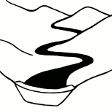Auto-Flowing Slurry Dam
(中国)
Falling Water Dam
描述
Auto-flowing slurry dams is filled with dense slurry by water flow from upland to maintain eroded soil particles and runoff.
Falling water filled dams distribute widely in the middle reaches of the Yellow River, they are used to store water and wrap sediment which result from soil and water loss. On the Loess Plateau, in addition to the conditions of deep gully and steep slope, earth above the top of the dams can be used to build dams. First, soil is loosed with squirt guns, exploded or manually dug. Then, water is pumped up to the loose earth so as to rush the soil down along transporting ditch, turning the soil into dense mud to dam level surrounded by tamped banks. Under the press of gravity, the mud dehydrates, consolidates and becomes uniformly dense body of the dams. Compared with dams in other areas, the water power filled dams in the Yellow River basin are characterized by much denser mud, uniform particles and body texture, smaller transect of dams body, and wide applicability to soil materials such as sand soil, loess soil and weathering residue. The types of dams have widely applied to build moderate and small reservoirs and silt arresters in the middle reaches of the Yellow River, they play an important role in increase in agricultural production and reduction of sediment into the Yellow River.
地点

地点: Shanxi, Shaanxi, etc., 中国
分析的技术场所数量:
技术传播: 均匀地分布在一个区域 (13062.0 km²)
在永久保护区?:
实施日期: 50多年前(传统)
介绍类型
-
通过土地使用者的创新
-
作为传统系统的一部分(> 50 年)
-
在实验/研究期间
-
通过项目/外部干预

Picture of auto-flowing slurry dam in the Loess Plateau (LIU Baoyuan (Beijing China))
主要目的
-
改良生产
-
减少、预防、恢复土地退化
-
保护生态系统
-
结合其他技术保护流域/下游区域
-
保持/提高生物多样性
-
降低灾害风险
-
适应气候变化/极端天气及其影响
-
减缓气候变化及其影响
-
创造有益的经济影响
-
创造有益的社会影响
土地利用
-
水道、水体、湿地 - 池塘、大坝
主要产品/服务: Auto-Flowing Slurry Dam
供水
土地退化相关的目的
-
防止土地退化
-
减少土地退化
-
修复/恢复严重退化的土地
-
适应土地退化
-
不适用
解决的退化问题
-
土壤水蚀 - Wt:表土流失/地表侵蚀 , Wg:冲沟侵蚀/沟蚀
-
化学性土壤退化 - Cn:肥力下降和有机质含量下降(非侵蚀所致)
技术建立与维护:活动、投入和费用
投入和成本的计算
- 计算的成本为:
- 成本计算使用的货币:美元
- 汇率(换算为美元):1 美元 = 不适用
- 雇用劳工的每日平均工资成本:3.00
影响成本的最重要因素
Since the dam construction uses local materials, the most important factors affecting the cost are labor and equipment
技术建立活动
-
preparing earth (时间/频率: n/a)
-
pumping water (时间/频率: n/a)
-
preparing base of the dam and its perimetric banks (时间/频率: n/a)
-
Flushing the prepared earth with water inside the banks of the dam (时间/频率: 0.1~1)
-
After dehydration and consolidation of the earth, repeat 3 and 4. (时间/频率: n/a)
技术维护活动
-
Keeping the top of the dam level and free of crevice, water or rubbish (时间/频率: timely)
-
Keeping the top of the dam level and free of crevice, water or rubbish (时间/频率: None)
-
Keeping the slope of the dam compact and free of rill or weed. (时间/频率: timely)
-
Keeping the slope of the dam compact and free of rill or weed. (时间/频率: None)
-
Keeping the observation equipment work in order. (时间/频率: timely)
-
Keeping the observation equipment work in order. (时间/频率: None)
-
Preventing the base the dam from destroying by white ants and other animals. (时间/频率: April to October/once a year)
自然环境
年平均降雨量
-
< 250毫米
-
251-500毫米
-
501-750毫米
-
751-1,000毫米
-
1,001-1,500毫米
-
1,501-2,000毫米
-
2,001-3,000毫米
-
3,001-4,000毫米
-
> 4,000毫米
关于气候的规范
不适用
斜坡
-
水平(0-2%)
-
缓降(3-5%)
-
平缓(6-10%)
-
滚坡(11-15%)
-
崎岖(16-30%)
-
陡峭(31-60%)
-
非常陡峭(>60%)
海拔
-
0-100 m a.s.l.
-
101-500 m a.s.l.
-
501-1,000 m a.s.l.
-
1,001-1,500 m a.s.l.
-
1,501-2,000 m a.s.l.
-
2,001-2,500 m a.s.l.
-
2,501-3,000 m a.s.l.
-
3,001-4,000 m a.s.l.
-
> 4,000 m a.s.l.
土壤深度
-
非常浅(0-20厘米)
-
浅(21-50厘米)
-
中等深度(51-80厘米)
-
深(81-120厘米)
-
非常深(> 120厘米)
土壤质地(表土)
-
粗粒/轻(砂质)
-
中粒(壤土、粉土)
-
细粒/重质(粘土)
土壤质地(地表以下>20厘米)
-
粗粒/轻(砂质)
-
中粒(壤土、粉土)
-
细粒/重质(粘土)
水质(未处理)
-
良好饮用水
-
不良饮用水(需要处理)
-
仅供农业使用(灌溉)
-
不可用
应用该技术的土地使用者的特征
非农收入
-
低于全部收入的10%
-
收入的10-50%
-
> 收入的50%
个人或集体
-
个人/家庭
-
团体/社区
-
合作社
-
员工(公司、政府)
每户使用面积
-
< 0.5 公顷
-
0.5-1 公顷
-
1-2 公顷
-
2-5公顷
-
5-15公顷
-
15-50公顷
-
50-100公顷
-
100-500公顷
-
500-1,000公顷
-
1,000-10,000公顷
-
> 10,000公顷
土地所有权
-
州
-
公司
-
社区/村庄
-
团体
-
个人,未命名
-
个人,有命名
采用和适应
在所有采用这种技术的人当中,有多少人在没有获得物质奖励的情况下采用了这种技术?
-
0-10%
-
11-50%
-
51-90%
-
91-100%
户数和/或覆盖面积
80'000 households (3 percent of the area)
最近是否对该技术进行了修改以适应不断变化的条件?
什么样的变化条件?
-
气候变化/极端气候
-
不断变化的市场
-
劳动力可用性(例如,由于迁移)
结论和吸取的教训
长处: 土地使用者的观点
长处: 编制者或其他关键资源人员的观点
弱点/缺点/风险: 土地使用者的观点如何克服
弱点/缺点/风险: 编制者或其他关键资源人员的观点如何克服
参考文献
审查者
-
David Streiff
-
Alexandra Gavilano
实施日期: Dec. 6, 2010
上次更新: March 14, 2019
文件编制者
机构
- Department of Resources and Environmental Science, Beijing Normal University (Department of Resources and Environmental Science, Beijing Normal University) - 中国
项目
主要参考文献
-
Special Planning Of Soil And Water Conservation in Xinzhou Region , Shanxi Province. 1986-1990.: Library of the Resource and Environmental Department, Beijing Normal University.
-
How to design the dry masonry dam in the Hanjiachuan watershed. Tianyuzhu, Wangzuliang. Beijing. Water conservation in Beijing. 2000.: Library of the Resource and Environmental Department, Beijing Normal University.












